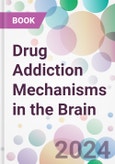Drug Addiction Mechanisms in the Brain explores the fascinating world of drug substances and their effects on the brain. This book provides a comprehensive overview of the ten major substances that contribute to drug addiction Information about each substance is presented in a specific chapter, shedding light on their biochemical mechanisms and physiological effects. From the stimulating effects of cocaine to the sedative properties of heroin, and the hallucinogenic experiences induced by LSD, the book takes the reader through the intricate pathways of addiction. Other substances covered in the book include alcohol, nicotine, MDMA, METH, morphine, ketamine, and fentanyl. Readers will gain an understanding about neurochemical alterations in the brain Anyone looking for interesting knowledge about the addictive nature of common drugs and their complex interplay with the brain will find this book informative.
Readership
Researchers, healthcare professionals, counsellors and general readers.Table of Contents
CHAPTER 1 COCAINE AND ITS EFFECTS ON THE BRAIN- INTRODUCTION
- Cocaine in Brain
- Effects of Cocaine on Brain Cells
- Cocaine at the Synapse
- Cocaine and Genetic Changes in Brain
- CONCLUSION
- REFERENCES
- INTRODUCTION
- Heroin and the Brain
- Action of Heroin on Mu-opioid Receptors
- CONCLUSION
- REFERENCES
- INTRODUCTION
- Norepinephrine (NE) and MDMA
- Antioxidant and Signalling Pathways and MDMA
- Non-human, Primates, and MDMA Effects
- Mitochondria and MDMA
- MDMA and Hippocampus
- Inflammatory Cytokines and MDMA
- CONCLUSION
- REFERENCES
- INTRODUCTION
- Neurocognitive Effects
- CONCLUSION
- REFERENCES
- INTRODUCTION
- Amphetamines and METH
- Impaired Neurogenesis
- Dopamine and METH
- CONCLUSION
- REFERENCES
- INTRODUCTION
- CONCLUSION
- REFERENCES
- INTRODUCTION
- Ketamine as Antidepressant
- Ketamine as an Anti-inflammatory Compound
- Ketamine Induces Apoptosis in Neuronal Cells
- CONCLUSION
- REFERENCES
- INTRODUCTION
- Hippocampus and Fentanyl
- Neurotoxic Effect of Fentanyl
- Noradrenaline and Fentanyl Receptors
- Mitochondria Damage and Fentanyl
- Fentanyl and Pain-related and Responsive Areas -PET Studies
- CONCLUSION
- REFERENCES
- INTRODUCTION
- Role of Toll-like Receptors in Ethanol-induced Changes
- Ethanol and Animal Studies
- Effects in Humans
- Ethanol and Alzheimer's Disease Model
- CONCLUSION
- REFERENCES
- INTRODUCTION
- Nicotine in the Ageing Brain
- Nicotine and Fetal Brain Development
- Nicotine and Adolescent Brain
- Nicotinic Acetylcholine Receptors (nAChRs) in Addiction to Tobacco Smoking 72
- CONCLUSION
- REFERENCES
- SUBJECT INDEX
Author
- Jayalakshmi Krishnan








